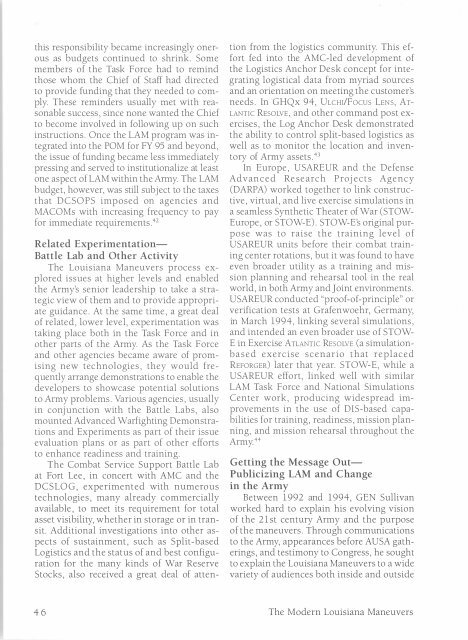The Modern Louisiana Maneuvers - US Army Center Of Military History
The Modern Louisiana Maneuvers - US Army Center Of Military History
The Modern Louisiana Maneuvers - US Army Center Of Military History
Create successful ePaper yourself
Turn your PDF publications into a flip-book with our unique Google optimized e-Paper software.
this responsibility became increasingly onerous<br />
as budgets continued to shrink. Some<br />
members of the Task Force had to remind<br />
those whom the Chief of Staff had directed<br />
to provide funding that they needed to comply.<br />
<strong>The</strong>se reminders usually met with reasonable<br />
success, since none wanted the Chief<br />
to become involved in following up on such<br />
instructions. Once the LAM program was integrated<br />
into the POM for FY 95 and beyond,<br />
the issue of funding became less immediately<br />
pressing and served to institutionalize at least<br />
one aspect of LAM within the <strong>Army</strong>. <strong>The</strong> LAM<br />
budget, however, was still subject to the taxes<br />
that DCSOPS imposed on agencies and<br />
MACOMs with increasing frequency to pay<br />
for immediate requirementsY<br />
Related Experimentation<br />
Battle Lab and Other Activity<br />
<strong>The</strong> <strong>Louisiana</strong> <strong>Maneuvers</strong> process explored<br />
issues at higher levels and enabled<br />
the <strong>Army</strong>'s senior leadership to take a strategic<br />
view of them and to proVide appropriate<br />
gUidance. At the same time, a great deal<br />
of related, lower level, experimentation was<br />
taking place both in the Task Force and in<br />
other parts of the <strong>Army</strong>. As the Task Force<br />
and other agencies became aware of promising<br />
new technologies, they would frequently<br />
arrange demonstrations to enable the<br />
developers to showcase potential solutions<br />
to <strong>Army</strong> problems. Various agencies, usually<br />
in conjunction with the Battle Labs, also<br />
mounted Advanced Warfighting Demonstrations<br />
and Experiments as part of their issue<br />
evaluation plans or as part of other efforts<br />
to enhance readiness and training.<br />
<strong>The</strong> Combat Service Support Battle Lab<br />
at Fort Lee, in concert with AMC and the<br />
DCSLOG, experimented with numerous<br />
technologies, many already commercially<br />
available, to meet its requirement for total<br />
asset visibility, whether in storage or in transit.<br />
Additional investigations into other aspects<br />
of sustainment, such as Split-based<br />
Logistics and the status of and best configuration<br />
for the many kinds of War Reserve<br />
Stocks, also received a great deal of atten-<br />
46<br />
tion from the logistics community. This effort<br />
fed into the AMC-Ied development of<br />
the Logistics Anchor Desk concept for integrating<br />
logistical data from myriad sources<br />
and an orientation on meeting the customer's<br />
needs. In GHQx 94, ULCHI/Focus LENS, AT<br />
LANTIC RESOLVE, and other command post exercises,<br />
the Log Anchor Desk demonstrated<br />
the ability to control split-based logistics as<br />
well as to monitor the location and inventory<br />
of <strong>Army</strong> assets.43<br />
In Europe, <strong>US</strong>AREUR and the Defense<br />
Advanced Research Proj ects Agency<br />
(DARPA) worked together to link constructive,<br />
virtual, and live exercise simulations in<br />
a seamless Synthetic <strong>The</strong>ater of War (STOW<br />
Europe, or STOW-E). STOW-E's original purpose<br />
was to raise the training level of<br />
<strong>US</strong>AREUR units before their combat training<br />
center rotations, but it was found to have<br />
even broader utility as a training and mission<br />
planning and rehearsal tool in the real<br />
world, in both <strong>Army</strong> and Joint environments.<br />
<strong>US</strong>AREUR conducted "proof-of-principle" or<br />
verification tests at Grafenwoehr, Germany,<br />
in March 1994, linking several simulations,<br />
and intended an even broader use of STOW<br />
E in Exercise ATLANTIC RESOLVE (a simulationbased<br />
exercise scenario that replaced<br />
REFORGER) later that year. STOW-E, while a<br />
<strong>US</strong>AREUR effort, linked well with similar<br />
LAM Task Force and National Simulations<br />
<strong>Center</strong> work, pro ducing widespread improvements<br />
in the use of DIS-based capabilities<br />
for training, readiness, mission planning,<br />
and mission rehearsal throughout the<br />
<strong>Army</strong>. 44<br />
Getting the Message Out<br />
Publicizing LAM and Change<br />
in the <strong>Army</strong><br />
Between 1992 and 1994, GEN Sullivan<br />
worked hard to explain his evolving vision<br />
of the 21st century <strong>Army</strong> and the purpose<br />
of the maneuvers. Through communications<br />
to the <strong>Army</strong>, appearances before A<strong>US</strong>A gatherings,<br />
and testimony to Congress, he sought<br />
to explain the <strong>Louisiana</strong> <strong>Maneuvers</strong> to a wide<br />
variety of audiences both inside and outside<br />
<strong>The</strong> <strong>Modern</strong> <strong>Louisiana</strong> <strong>Maneuvers</strong>
















